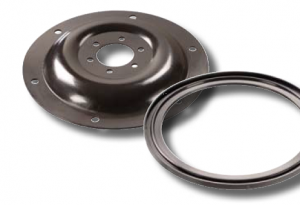EPR vs EPDM - How do they differ?
What’s the difference between EPR and EPDM? What do the different abbreviations (EPR, EPM, EPDM, EPT, etc.) mean? These questions pop up from time to time in the seal industry, and here are basic answers to these questions.

First of all, polymers (derived from the Greek for “many units”) are long chemical chains that can be thought of as behaving like long pieces of cooked spaghetti. Each chain is made of one or more monomers (Greek “single unit”) linked together end-to-end. A copolymer (Greek “two units”) is composed of two monomers, while a terpolymer (Greek “three units”) is composed of three monomers. EPR (aka EPM, EP copolymer) contains only ethylene and propylene monomers. EPDM (aka EPT, EP terpolymer) is composed of ethylene, propylene, and a third monomer called a diene (three different dienes are in common use today, but discussing their differences gets extremely dry and technical.)
To make a rubber material rubbery, we essentially have to “glue” the polymer chains together. We do this through a process called vulcanization or curing. This is where the subtle difference between EPR and EPDM is found. Because of the chemistry of the polymer chain, EPR can only be vulcanized with a peroxide-based cure system. On EPDM, the additional diene monomer provides a specialized cure site that allows the polymer to be vulcanized with peroxide- or sulfur-based chemistries. Because of this added flexibility, most EP compounds in the seal industry today use EPDM terpolymer instead of EPR copolymer. In other industries (hose, roofing products, etc.) EPRs may still be the material of choice.
From a functional standpoint, there are very few performance differences between EPR and EPDM. Both swell dramatically in petroleum products, and both are excellent in water, steam, and polar solvents like MEK and acetone. There are some notable performance differences in extremely demanding applications: EPRs or very tightly cured EPDMs are suited for the nuclear industry (E0740-75 is recommend), and for applications involving concentrated acetic acid, some EPDM compounds (like E0692-75) show superior performance to most EPRs. In other applications, the performance difference is difficult (if not impossible) to identify.
The original article was written by our partners at Parker and can be found on their website here.
For more information about which material(s) might be the best fit for your specific application, contact Gallagher Fluid Seals' engineering department.
